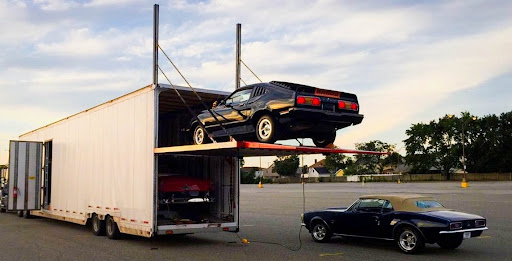Transporting a vintage automobile requires meticulous care and planning. The expenditures involved can fluctuate substantially, influenced by factors like distance, vehicle size, shipping mode, and specialized services.
This comprehensive guide goes into the intricate realm of classic car shipping costs, empowering enthusiasts with invaluable insights.
Determining Factors: Distance and Carrier Type
Two pivotal elements shape the foundational expenses: transportation span and automobile measurements. Longer hauls inevitably demand higher fees, as fuel consumption and labor costs escalate proportionally with mileage.
Conversely, compact classic cars often garner lower rates compared to their larger counterparts, owing to their reduced cargo space requirements. The most cost-determining factor after the distance is the type of carrier. Open costs 30-40% less than enclosed:
| Distance (miles) | Open Carrier ($) | Enclosed Carrier Cost ($) |
| 0-500 | 500 | 700 |
| 500-999 | 700 – 750 | 900 – 1,050 |
| 1,000-2,000 | 600 – 1,000 | 800 – 1,300 |
This table illustrates the approximate costs for compact and full-size classic cars across various mileage tiers within the continental United States. Overseas transport necessitates additional expenditures for maritime freight and customs clearance.
Shipping Modes: Weighing the Pros and Cons
Enthusiasts can choose from a trio of conveyance methods: open carriers, enclosed carriers, and air freight. Each option presents distinct merits and drawbacks concerning pricing, security, transit duration, and logistical complexity.
- Open Carriers: The most economical shipping solution, ideal for shorter distances. Classic cars are exposed to environmental conditions, heightening the risk of damage.
- Enclosed Carriers: Providing comprehensive protection, these trucks shield vehicles from external hazards. Expenses tend to be higher, yet justified for long-haul journeys or irreplaceable collector’s items.
- Air Freight: The swiftest alternative, air transport minimizes transit times but incurs exorbitant fees. Reserved for urgencies or extraordinary circumstances involving ultra-rare, high-value automobiles.
Supplementary Services: Ensuring Seamless Logistics
Beyond mere transportation, ancillary offerings can streamline the shipping process while elevating costs accordingly. Doorstep pick-up and delivery eliminate the need for separate vehicle conveyance, albeit at a premium. In-transit insurance safeguards against potential damages, with premiums proportional to the automobile’s appraised worth. Shipping a Classic Car
Industry authorities advocate enlisting professional assistance from reputable classic car transporters. Their expertise encompasses vehicle preparation, specialized equipment usage, meticulous handling protocols, and regulatory compliance – factors that justify the augmented expenditure.
Regional Disparities: Urban vs. Rural Dynamics
Geographical location exerts a tangible impact on shipping outlays. Dense metropolitan areas often command higher rates due to congestion, limited access, and elevated operational overheads. Conversely, rural locales typically translate to more affordable services, as long-haul trucking dominates the cost structure.
For instance, transporting a full-size classic from New York City to Los Angeles may cost upwards of $1,300 via open carrier, while a comparable rural-to-rural journey could be 25% less expensive. Shipping Cars Company
Seasonal Fluctuations: Navigating Peak Periods
Like many industries, classic car shipping witnesses periodic spikes in demand, predominantly during summer months and major automotive events. Carriers capitalize on this heightened interest by implementing peak season surcharges, potentially inflating costs by 10-20% compared to off-peak periods.
Savvy enthusiasts can circumvent these premiums by scheduling shipments during slower seasons, albeit at the expense of prolonged wait times or limited carrier availability.
Case Studies: Real-World Transport Scenarios
To illustrate the cost dynamics, let’s examine two hypothetical shipping scenarios:
- Short-Distance Open Transport: John, residing in Dallas, Texas, acquires a 1967 Ford Mustang from a seller in Oklahoma City, approximately 200 miles away. Opting for open carrier transport, he can expect to pay between $200 and $400 for door-to-door delivery, excluding any supplementary services.
- Cross-Country Enclosed Carrier: Sarah, a Los Angeles-based collector, purchases a pristine 1957 Chevrolet Bel Air from an East Coast dealer in Miami, Florida. Prioritizing vehicle security, she selects an enclosed carrier for the nearly 3,000-mile journey. The estimated cost ranges from $1,500 to $1,700, factoring in potential peak season surcharges and optional services like door-to-terminal delivery.
Parting Words: Balancing Costs and Priorities
Shipping a classic car involves intricate cost considerations that extend beyond mere transportation fees.
By carefully evaluating factors like distance, vehicle size, shipping mode, supplementary services, location, and seasonality, enthusiasts can make informed decisions that align with their budgets and priorities.
Ultimately, the investment in secure and reliable logistics services ensures the preservation of these automotive treasures, sustaining their legacy for generations to come.

